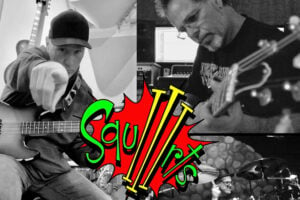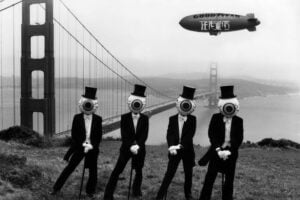
Feature Photo: Adam McCullough / Shutterstock.com
Some words seem made for rock and roll — “star” might just be one of them. It flickers between fame and failure, between the unreachable night sky and the glaring spotlight of the stage. Over the years, musicians have turned that word into everything from a beacon of hope to a warning sign, bending its meaning to fit stories of triumph, tragedy, and everything in between. In these ten songs, “star” is never just about twinkling lights above — it’s a symbol that cuts to the heart of what it means to chase dreams, face demons, and sometimes burn out before ever getting to shine.
Grace Potter and the Nocturnals transformed the word into a quiet cry of heartbreak in “Stars,” a song that lingers in grief as much as it reaches for the heavens. Earth, Wind & Fire’s “Shining Star” explodes with life, turning the idea of being a star into a statement of self-worth and determination. Bad Company’s “Shooting Star” brings the myth of the rock hero crashing down to earth, reminding listeners how fast fame can slip away. Jimi Hendrix took “The Star-Spangled Banner” and dragged it through distortion and feedback to capture the chaos of a country at war with itself. Deep Purple’s “Highway Star” charged ahead with speed and swagger, making no apologies for its fast-lane obsession.
The Grateful Dead used “Dark Star” as a vessel for their wildest live experiments, stretching time and space in a way only they could. David Bowie’s “Starman” gave a generation a message from another world, mixing cosmic fantasy with a deeply human need to believe in something bigger. Sly and the Family Stone’s “Everybody Is a Star” gave a soft but powerful reminder that greatness doesn’t belong to the few — it lives in all of us. The Rolling Stones took the word into far more dangerous territory with “Star Star,” peeling back the glitz to show the ugly side of stardom. And The Byrds, ever the sharp-eyed observers, delivered “So You Want to Be a Rock ‘n’ Roll Star,” a song that asks whether all the lights are really worth the cost.
# 10 – Stars – Grace Potter And The Nocturnals
Released as the third single from The Lion the Beast the Beat, “Stars” by Grace Potter and the Nocturnals is one of the band’s most emotionally charged ballads, showcasing Potter’s powerful vocals against a backdrop of moody, atmospheric instrumentation. The track was recorded between 2011 and 2012 at Bear Creek Studio in Woodinville, Washington, and The Studio in Los Angeles, California, with producer Jim Scott at the helm. Known for his work with artists like Tom Petty and the Foo Fighters, Scott helped craft a sound that was both expansive and intimate, bringing out the song’s raw vulnerability. The lineup for The Lion the Beast the Beat included Grace Potter on vocals, keyboards, and guitar, Scott Tournet on guitars and backing vocals, Matt Burr on drums, Michael Libramento on bass and keyboards, and Benny Yurco on guitar.
Read More: Top 10 Grace Potter And The Nocturnals Songs
# 9 – Shining Star – Earth, Wind & Fire
Opening with a punchy guitar riff and a rhythm section that refuses to sit still, “Shining Star” captures Earth, Wind & Fire in the midst of one of their most energized creative periods. Recorded in 1974 at Caribou Ranch in the mountains of Colorado, the song grew out of a jam session during the sessions for That’s the Way of the World, with producer and bandleader Maurice White working alongside guitarist Al McKay and keyboardist Larry Dunn to shape the final track. By the time “Shining Star” was finished, it featured the full ensemble firing on all cylinders: White on vocals and drums, Verdine White on bass, Philip Bailey contributing both vocals and percussion, McKay and Johnny Graham on guitars, Dunn on keyboards, and Ralph Johnson on additional percussion. The secluded recording location gave the band space to experiment, and the result was a musically tight track that carried an easy, effortless vibe. “Shining Star” reached No. 1 on both the Billboard Hot 100 and the Hot Soul Singles chart, making it Earth, Wind & Fire’s first No. 1 hit and a major crossover success.
Read More: Top 10 Earth, Wind & Fire Songs
# 8 – Dark Star – Grateful Dead
“Dark Star” remains one of the Grateful Dead’s most ambitious and enduring works, a song that not only defined the band’s approach to improvisation but also became a symbol of their creative peak during the late 1960s and early 1970s. The original studio version of “Dark Star” was recorded in 1968 at Pacific High Recording in San Francisco and released as a single on April 21, 1968, with “Born Cross-Eyed” as its B-side. Produced by the Grateful Dead and Dan Healy, the studio cut runs just over two and a half minutes, but it was onstage where the song truly came alive. The lineup at the time featured Jerry Garcia on lead guitar and vocals, Bob Weir on rhythm guitar and vocals, Phil Lesh on bass, Bill Kreutzmann and Mickey Hart on drums and percussion, Ron “Pigpen” McKernan on keyboards and percussion, and lyricist Robert Hunter, who contributed some of the band’s most abstract and poetic lyrics for this track.
Read More: Complete List Of Grateful Dead Band Members
# 7 – Everybody is a Star – Sly and the Family Stone
Released in December 1969 as the B-side to the iconic “Thank You (Falettinme Be Mice Elf Agin),” “Everybody Is a Star” was recorded during a period of creative high point for Sly and the Family Stone. Produced by Sly Stone (born Sylvester Stewart), the track was laid down at Pacific High Recording in San Francisco, where much of the band’s late ’60s material was captured. Although “Everybody Is a Star” was originally issued as a non-album single, it was later included on Greatest Hits (1970), one of the best-selling compilations of the era and an essential portrait of the band’s groundbreaking fusion of funk, soul, rock, and psychedelia. The track features Sly Stone on vocals, keyboards, and guitar, Freddie Stone on guitar, Larry Graham on bass, Rose Stone on keyboards and vocals, Cynthia Robinson on trumpet, Jerry Martini on saxophone, and Greg Errico on drums, embodying the band’s signature multi-racial, multi-gender lineup. Together with “Thank You (Falettinme Be Mice Elf Agin),” the single reached No. 1 on the Billboard Hot 100 and the Hot Soul Singles chart, marking a major commercial success for the band.
Read More: Top 10 Sly And The Family Stone Songs
# 6 – So You Want to Be a Rock ‘n’ Roll Star – The Byrds
Released in January 1967, “So You Want to Be a Rock ‘n’ Roll Star” is one of The Byrds’ sharpest and most self-aware tracks, offering a satirical look at the music industry’s obsession with manufactured fame. The song was recorded in late 1966 at Columbia Studios in Hollywood, California, and produced by Gary Usher, who had recently begun working with the band as they moved into more experimental territory. Written by Roger McGuinn and Chris Hillman, the song was issued as a single before appearing on Younger Than Yesterday, The Byrds’ fourth studio album. The musicians featured on the track include McGuinn on twelve-string Rickenbacker guitar and lead vocals, Hillman on bass and co-lead vocals, Michael Clarke on drums, and David Crosby on rhythm guitar and backing vocals. Upon release, “So You Want to Be a Rock ‘n’ Roll Star” reached No. 29 on the Billboard Hot 100 chart, a modest success compared to earlier Byrds hits like “Mr. Tambourine Man” and “Turn! Turn! Turn!”
Read More: Complete List Of The Byrds Band Members
# 5 – Star Star – The Rolling Stones
“Star Star,” released as the closing track on Goats Head Soup in August 1973, is one of the Rolling Stones’ most controversial and unabashedly provocative songs. Produced by Jimmy Miller, who had worked on many of the Stones’ pivotal records throughout their late ’60s and early ’70s period, “Star Star” is driven by a raw, Chuck Berry-inspired riff and features Mick Jagger on lead vocals, Keith Richards and Mick Taylor on guitars, Bill Wyman on bass, and Charlie Watts on drums.
Read More: Complete List Of The Rolling Stones Albums And Discography
# 4 – Starman – David Bowie
David Bowie’s “Starman,” released in April 1972, marked a turning point in his career, serving as a breakthrough single that introduced audiences to his Ziggy Stardust persona. Recorded in February 1972 at Trident Studios in London, “Starman” was produced by Bowie and Ken Scott, a key figure in shaping the sound of The Rise and Fall of Ziggy Stardust and the Spiders from Mars. The recording featured Bowie on lead vocals, acoustic guitar, and stylophone, with Mick Ronson contributing electric guitar and string arrangements, Trevor Bolder on bass, and Mick Woodmansey on drums. Originally, RCA Records had not planned for “Starman” to be included on the Ziggy Stardust album, but after hearing its potential, Bowie and his team made the decision to add it—an inclusion that would play a critical role in the album’s success.
Upon release, “Starman” climbed to No. 10 on the UK Singles Chart and became Bowie’s first significant hit since “Space Oddity” in 1969. Its commercial success was bolstered by Bowie’s now-legendary performance on Top of the Pops in July 1972, where his charismatic delivery and arm draped casually over Mick Ronson’s shoulder captivated television audiences and catapulted him into stardom.
Read More: 20 Most Classic David Bowie Songs
# 3 – Highway Star – Deep Purple
“Highway Star” was born on the road, crafted during a bus ride to a gig in Portsmouth, England, in 1971. The song was officially recorded later that year at the Pye Mobile Studios during sessions for Machine Head, Deep Purple’s landmark 1972 album. Produced by the band along with engineer Martin Birch, “Highway Star” captures the raw energy and technical precision that defined Deep Purple’s classic Mark II lineup: Ian Gillan on vocals, Ritchie Blackmore on lead guitar, Jon Lord on organ, Roger Glover on bass, and Ian Paice on drums. The recording took place at the Grand Hotel in Montreux, Switzerland, which had been converted into a makeshift studio after the famous fire that inspired “Smoke on the Water.”
Read More: Ian Paice of Deep Purple: The ClassicRockHistory.com Interview
# 2 – Shooting Star – Bad Company
Bad Company’s “Shooting Star” is a rare moment of storytelling within the band’s catalog, offering a somber narrative about the rise and fall of a fictional rock icon. Recorded in 1975 for their second studio album Straight Shooter, the song was tracked at Clearwell Castle in Gloucestershire, England — a site known for its raw and atmospheric acoustics that suited the band’s stripped-down approach. The album was produced by Peter Grant, who also managed Led Zeppelin, alongside the band itself. The lineup featured Paul Rodgers on lead vocals and rhythm guitar, Mick Ralphs on lead guitar, Boz Burrell on bass, and Simon Kirke on drums. The sessions for Straight Shooter took place over late 1974 and early 1975, capturing Bad Company at a time when they were rapidly cementing their place as one of rock’s most dependable and influential acts.
Read More: Top 10 Bad Company Songs
# 1 – Star Spangled Banner – Jimi Hendrix
Jimi Hendrix’s interpretation of “The Star-Spangled Banner” at Woodstock in August 1969 remains one of the most arresting and politically charged performances in rock history. Recorded live on the morning of August 18, 1969, during the final set of the legendary Woodstock Festival in Bethel, New York, Hendrix’s performance stood out not only for its musical innovation but for its unflinching reflection of the chaotic spirit of the era. Accompanied by his short-lived ensemble, Gypsy Sun and Rainbows, Hendrix reimagined the American national anthem through layers of distortion, feedback, and whammy bar manipulations. The band for this performance included Billy Cox on bass, Mitch Mitchell on drums, Larry Lee on rhythm guitar, and percussionists Juma Sultan and Jerry Velez, though Hendrix performed the anthem solo. The performance was self-directed and not tied to a formal studio production, and it was later released in various live recordings, including the Woodstock: Music from the Original Soundtrack and More compilation in 1970.
Read More: Complete List Of Jimi Hendrix Songs From A to Z
Check out similar articles on ClassicRockHistory.com Just click on any of the links below……
Read More: Artists’ Interviews Directory At ClassicRockHistory.com
Read More: Classic Rock Bands List And Directory
Updated July 31, 2025



































